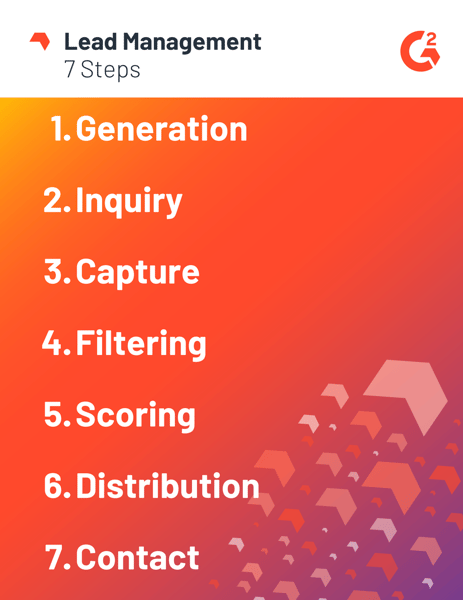Helping a potential customer expand their vision to see how your business can solve their problems is what lead management is all about.
Expounding upon the benefits that your product or service is a crucial element to any business strategy, and the whole reason the marketing to sales pipeline exists in the first place. While there are several ways to do this — indeed, finding inventive new ways to wrest markets into existence is one of the defining characteristics of the capitalist mode of production— lead management is the current manifestation of the process by which businesses attempt to carve out and ever larger piece of the market pie.
Lead management defined
But what exactly is lead management? What mystic powers must you invoke in order to conjure a seemingly endless wellspring of business from your fingertips, creating wealth to make the J.P. Morgan himself weep with envy?
Why is lead management important?
Lead management has numerous benefits for business as it helps turn interest into direct sales. This is a critical strategy to continue the growth of any business by systematically creating a larger client base.
Simply put, lead management is the process by which potential customers — referred to as “leads” for short — are identified, acquired, and managed so that they move from simple awareness of your brand and business to dedicated clients who turn into lucrative sources of new business. 30-50% of new business goes to the proactive vendor, so ensuring your on top of your game can be the difference between making a new sale or floundering in stagnation.
Understanding this process is critical if you seek to turn your business into a viable source of capital and capture the attention of the market at large.
The lead management lifecycle
Managing a lead has much more to it than simply presenting an on-the-rails experience to a prospective client. Not only must you help the lead see why it requires you to ensure proper alignment of the various teams in sales and marketing so that a unified message is presented to prospective new clients. Below, you can find a step-by-step process outlining the lifecycle of lead management:

1. Lead generation
Before you can implement your impeccably-crafted lead management strategy, you first have to spark interest in your business. This is where your content marketing team is an invaluable asset. Find ways to show that your business can address the known and unknown desires and needs of as many people as possible and you’ll have your brand on the lips of more people than you bargained for.
2. Lead inquiry
Now that you have buzz surrounding your business, you need to construct an effective way to channel this potential energy. Lead-capture techniques such as effective call-to-actions embedded in content and general links back to your business’ main offering allow you to understand which of your customers are interested in your offerings.
3. Lead capture
The next step of the lead management lifecycle, lead capture, is when you build a portrait of who your customer actually is. This can best be accomplished with strategies such as targeted, personalized email marketing and submission forms on your content to solicit this information from visitors to your content
You can also use lead intelligence tools to help you capture the identity of potential leads, though these tend to be slightly less accurate than self-selected leads generated through compelling content.
4. Lead filtering
This part is one of the most simple, yet essential elements of lead management. Once you have acquired a set of identities through the various capture methods at your disposal, you need to verify these potential leads for accuracy of information so you know precisely who your spending your effort on, to better tailor your messaging and strategy.
5. Lead scoring
Now that you’ve identified the potential leads, it’s time to lead score them based on the potential value to your company. A student at the local university, while important to the future of society, hardly qualifies as a potential stream of business revenue. Your CEO’s yacht isn’t going to pay for itself, after all! Make sure to prioritize leads for people to whom you could realistically envision making a sales pitch to in order to maximize the potential of your sales team’s energy!
6. Lead distribution
After these scores have been assigned, it’s time to bring the leads to the attention of the relevant sales and marketing personnel, with as much background information as can be provided.
7. Lead contact
And with that, the work of lead management is done! It’s up to your sales-people to make contact with the appropriate leads, armed and equipped with the data generated from your marketing pipeline, to have the best possible shot at turning this new business opportunity into tangible revenue results.
The power of marketing automation software
With all that, it’s evident that there’s a lot of moving parts in managing and generating leads for your business. One of the best things you can do to make sure your strategy is implemented in the most comprehensive and effective ways possible is by investing in an all-in-one marketing automation tool.
|
Looking for the best marketing automation platform for your needs? G2 has hundreds of verified, real user reviews to help you make the best decision possible:

|
Marketing automation software provides easy ways to automate marketing tools and workflows while providing overall analytics that can help qualify leads and create campaigns with a much better chance at landing you some new business.
To the victor, the spoils
Now that you know the nuts and bolts of lead management, you’re ready to begin tackling your own initiative to increase the scope of your business and grow your impact in the market.
Looking for more information to help supercharge your marketing strategy? Check out our guide on 5 lead nurturing techniques to follow!
 by Piper Thomson
by Piper Thomson
 by Piper Thomson
by Piper Thomson
 by Mary Clare Novak
by Mary Clare Novak